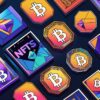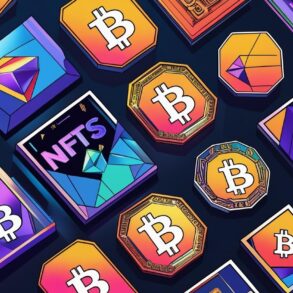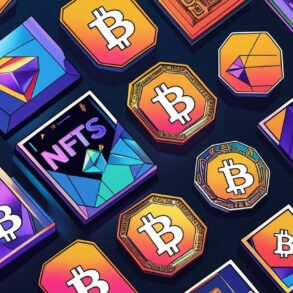New data shows that the sale of art NFTs has massively dropped since a boom in 2021, according to Statista.
There were only 1,459 sales of art NFTs last month. In the same month in 2021, there were more than 100,000.
Newsweek investigated which factors could be behind the decline in sales.
What Are NFTs Within The Art Industry?
Non-fungible tokens (NFTs) are a type of crypto asset that allows an investor to prove their ownership of real or digital items, including digital pieces of artwork.
NFTs are traded via blockchain technology, a form of data leger, and each NFT has its own identifying code and metadata, making each one irreplaceable.
An art NFT is a digital file that does not have physical copies and simply exists in the digital universe where investors and art collectors can buy and sell them.
Before art pieces became NFTs, digital art files could circulate online without clear ownership, so an art NFT establishes that ownership.

Mike Winkelmann, who goes by Beeple, shows off his digital art process in his home studio, Wednesday, Feb. 24, 2021. In 2021, Beeple sold an NFT file at Christie’s auction house for the huge price of $69 million.
Andrew J. Whitaker/The Post And Courier via AP
Why Were NFTs So Popular in 2021?
Discussing the rise in sales in 2021 with Newsweek, NYU Professor Amy Whitaker explained it was due to multiple factors.
Professor Whitaker said that in 2021, “You’re seeing early pioneers of blockchain-based work receive institutional recognition.”
One notable example is that in 2015, the artist Sarah Meyohas developed Bitchcoin, which was the first tokenization of art on the blockchain and a currency that was pegged to a square area of her own photos.
In that year, one Bitchcoin, sold for $100, was worth 25 square inches of any one of Meyohas’ photographic prints, according to WIRED, so to purchase a complete print, it required 25 Bitchcoins, equivalent to $2,500.
But in 2021, Bitchcoins were being auctioned off in bundles of 80 and 160 tokens and bidding would begin at $40,000, according to Vice, as the coin had migrated to the Ethereum network, the network which allows users to create and exchange NFTs.
Professor Whitaker explained there were also people entering the market because they “saw big sales,” joining those already in the market, “who had been early collectors of generative art,” and she referenced Pablo Rodriguez Fraile, who reportedly collected more than 2,000 pieces of digital art including work by Beeple and Refik Anadol, according to nft.com.
For example, in 2021, the artist Michael Winkelman, aka Beeple, sold an NFT with Christie’s auction house on March 11, according to the NFT news outlet nftnow.com, which gathered significant attention given that the auction price rocketed up to $69 million.
Other artists then began to follow suit where Edward Snowden sold a piece for $5 million in April, CryptoPunk #7523 sold one for $11 million and in December, XCopy sold one for $7 million, the outlet reported.
During this time, the sales of art NFTs massively increased. While in April 2021, there were 28,444 sales, in August that number was 117,378, according to Statista.
Outside of the art sector, there was a general increase in interest in NFTs in 2021 as NFT Virtual worlds and blockchain games were also released, according to nftnow.com.
Mark Cuban also joined the growing trend and made his own NFT, which was released on the NFT marketplace in January 2021.
More widely, Professor Whitaker added that there was a likely “cross-over of accumulated cryptocurrency wealth” where people might have wanted to “diversity within the space” without selling out of their crypto position.
It was reported by Vice that people had spent $174 million on NFTs since 2017, as the industry had gained a lot more interest.
Why Have NFTs Lost So Much Popularity Now?
After the boom in 2021, the Statista data showed a massive drop in the number of sales by 2022, when a year after the August 2021 burst of more than 117,000 sales, there were only 23,175 in the same month of 2022.
Discussing the drop in sales with Newsweek, Professor Whitaker explained that “you also have to look at the data going up in 2021.”
Part of the story is explained by the second law of thermodynamics, she added, as for “every action there is an equal and opposite reaction,” and in this case, she said she believed that the data shows “something that’s a little more nuanced than just a crash.”
One factor she said might be at play was that “surveyors of new technologies have moved on to AI” because “AI is more comfortable than blockchain,” and that general “investment has also moved from blockchain to AI.”
According to Analytics Insight, artificial intelligence (AI) is more accessible to people than blockchain technology, as the existence of large language models (LLMs) like Chat GPT makes AI feel more user-friendly, and the outlet added that people seemed to have a more positive reaction to AI because of that, and for its broader capability.
This shifting interest can be shown in the fact major companies are reportedly investing in AI art, including Google, Microsoft and Meta, according to Pixel Gallery.
An AI art company called Stability AI also raised $101 million between August 2022 and February 2023.
This post was originally published on this site be sure to check out more of their content








